AP Art History Units 1-6
1/780
There's no tags or description
Looks like no tags are added yet.
Name | Mastery | Learn | Test | Matching | Spaced |
|---|
No study sessions yet.
781 Terms
Adobe
a building material made from earth, straw, or clay dried in the sun
Aka
an elephant mask of the Bamileke people of Cameroon
Byeri
in the art of the Fang people, a reliquary guardian figure
Bundu
masks used by the women’s Sande society to bring girls into puberty
Cire perdue
the lost wax process. A bronze casting method in which a figure is modeled in clay and covered with wax and then recovered with clay. When fired in a kiln, the wax melts away, leaving a channel between the two layers of clay which can be used as a mold for liquid metal
Fetish
an object believed to possess magical powers
Ikenga
a shrine figure symbolizing traditional male attributes of the Igbo people
Lukasa
a memory board used by the Luba people of central Africa
Mblo
a commemorative portrait of the Baule people
Ndop
a Kuba commemorative portrait of a king in an ideal state
Nkisi n’kondi
a Kongo power figure
Pwo
a female mask worn by women of the Chokwe people
Scarification
scarring of the skin in patterns by cutting with a knife
Torons
wooden beams projecting from walls of adobe buildings
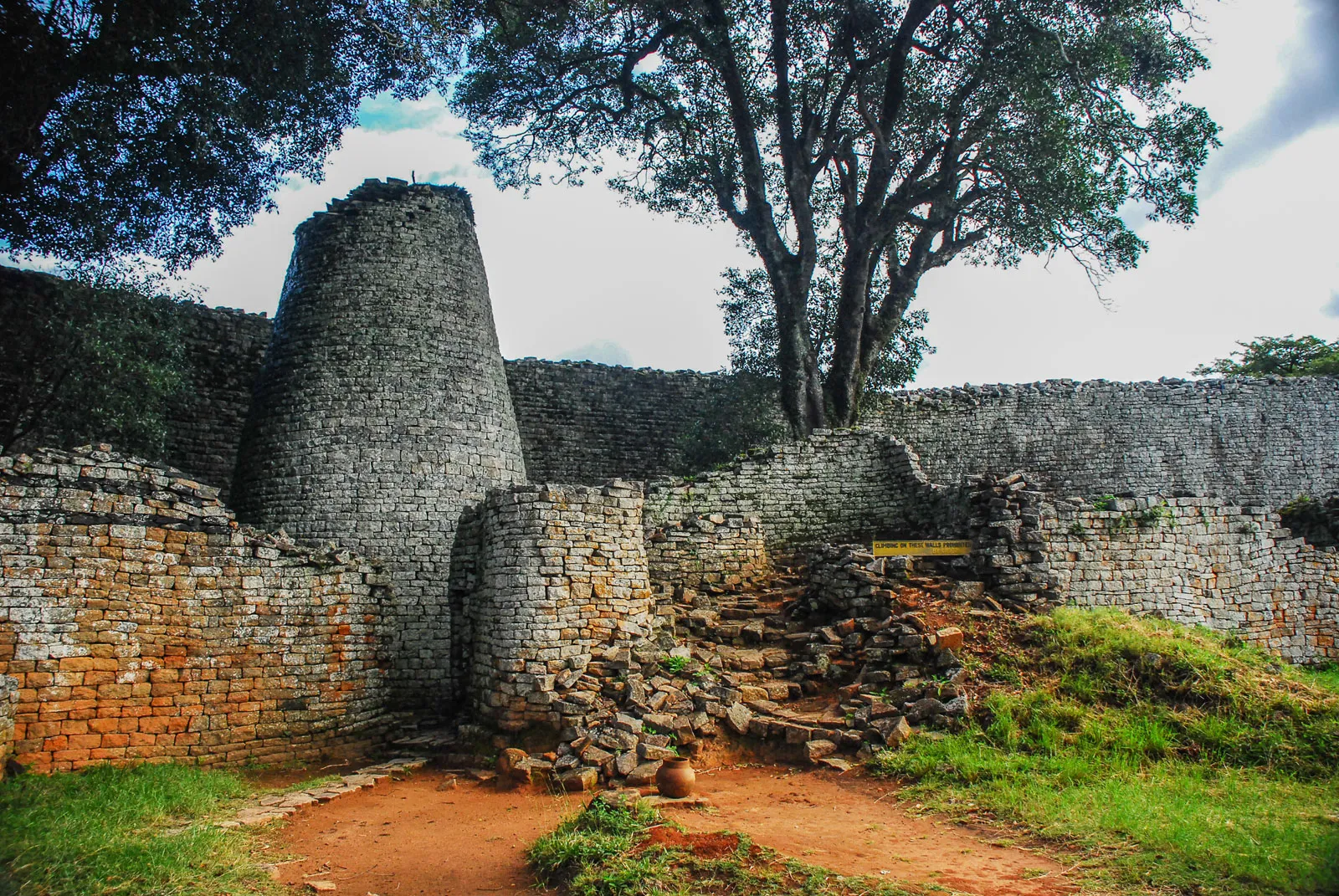
Great Zimbabwe
a prosperous trading center and royal complex; items from as far away as Persia and China have been found. Walls: 800 feet long, 32 feet tall; 17 feet thick at base. Internal and external passageways are tightly bounded, narrow, and long
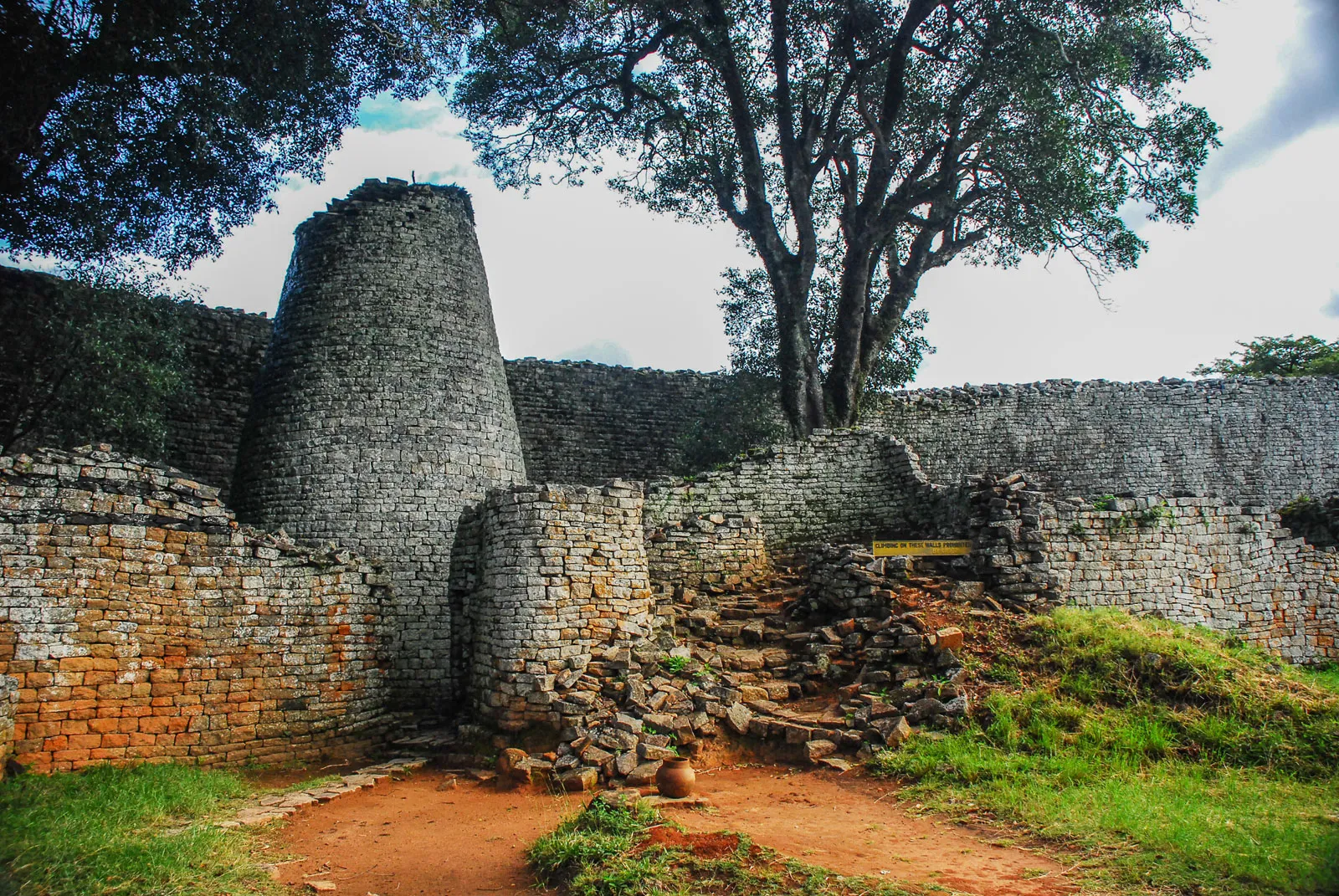
Canonical Tower, Great Zimbabwe
modeled on traditional shapes of grain silos; control over food symbolized wealth, power, and royal largesse. Resembles a granary and represented a good harvest and prosperity; grain gathered, stored, and dispensed as a symbol of royal power.
Zimbabwe
derives from a Shona term meaning “venerated houses” or “houses of stone.”
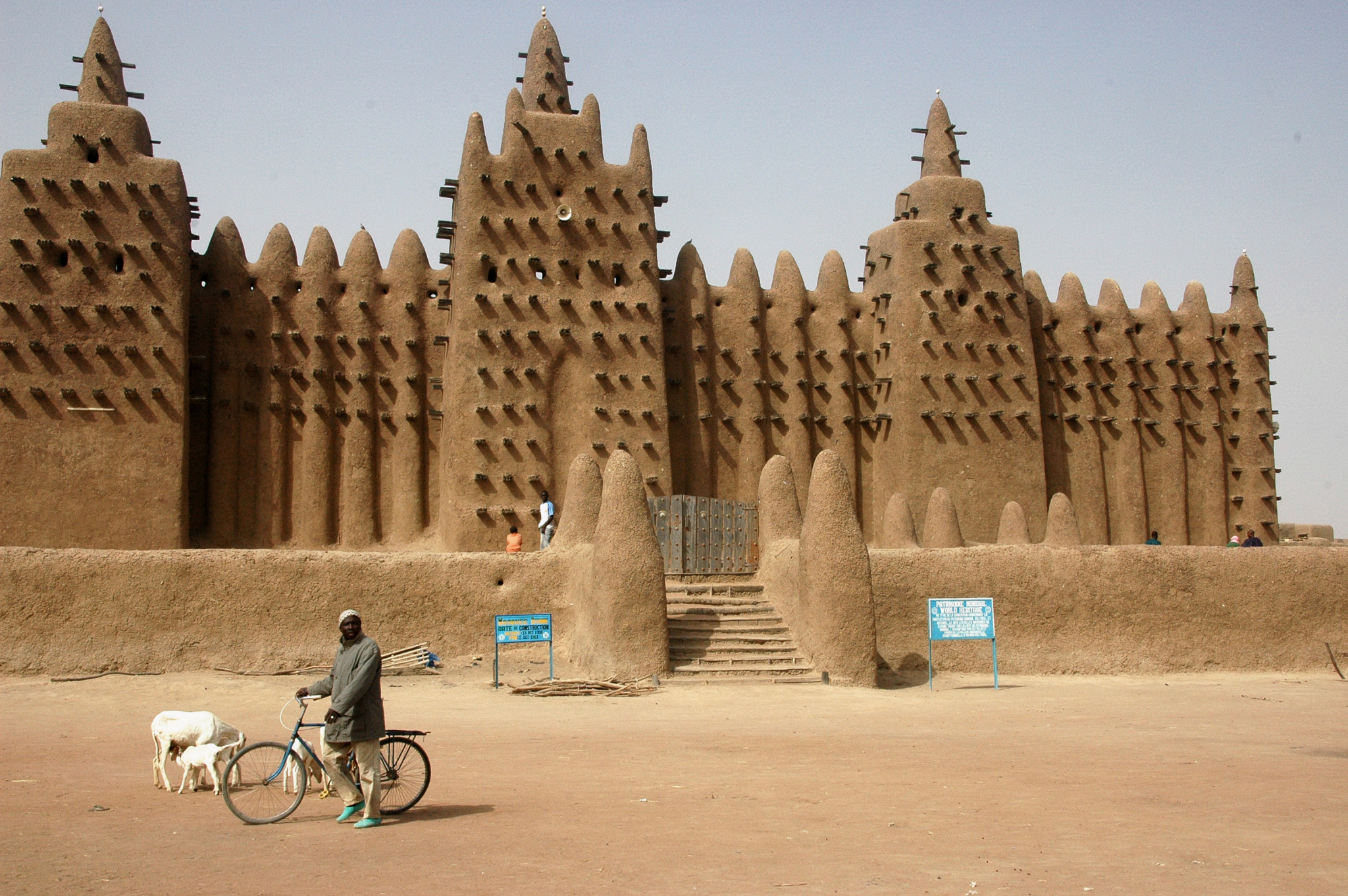
Great Mosque of Djenné
Crowning ornaments have ostrich eggs, symbols of fertility and purity. Roof has several holes with terra cotta lids to circulate air into the main room. Largest mud-brick mosque in the world.
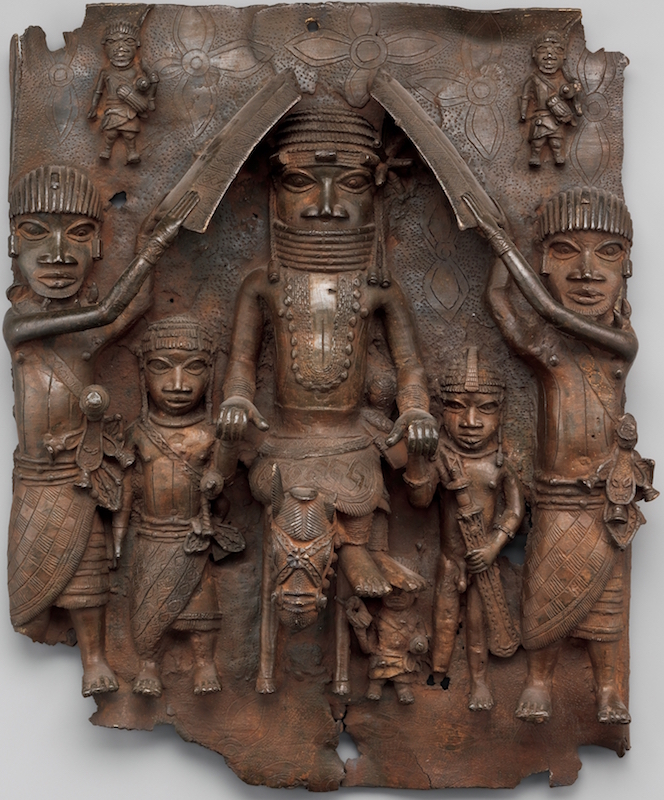
Benin Wall Plaque
One of 900 brass plaques produced, each between 16 and 18 inches. Shows aspects of court life in the Benin culture.It decorated the walls of the royal palace in Benin.
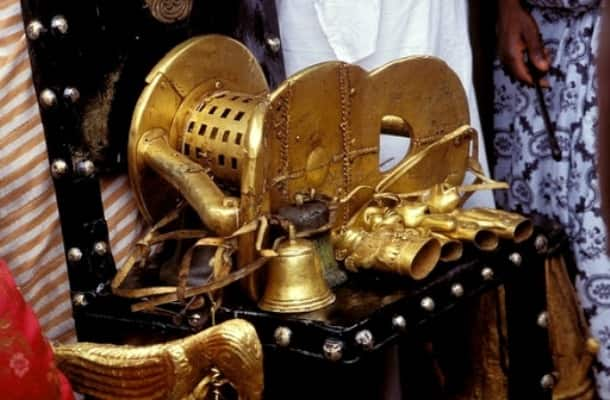
Golden Stool of Ashanti (Sika Dwa Kofi)
According to a tradition, it was brought down from heaven by a priest and fell into the lap of the Ashanti king, Osei Tutu. It became the repository of the spirit of the nation; it is the symbol of the mystical bond among all Ashanti.
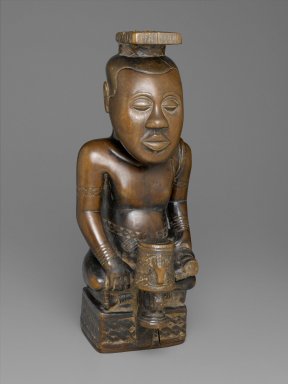
Ndop (portrait figure) of King Mishe miShyaang maMbul
Rubbed with oil to protect it from insects. Acted as a surrogate for the king in his absence. One of the earliest existing African wood sculptures; oldest ndop in existence. King’s charm.
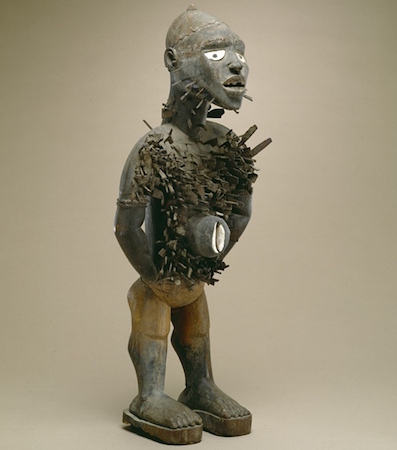
Power figure (Nkisi n’kondi)
Medical properties are inserted into the body cavity, thought to be a person’s life or soul. The figure has a role as a witness and enforcer of community affairs. In order to prod the image into action, nails and blades are often inserted into the work or removed from it.
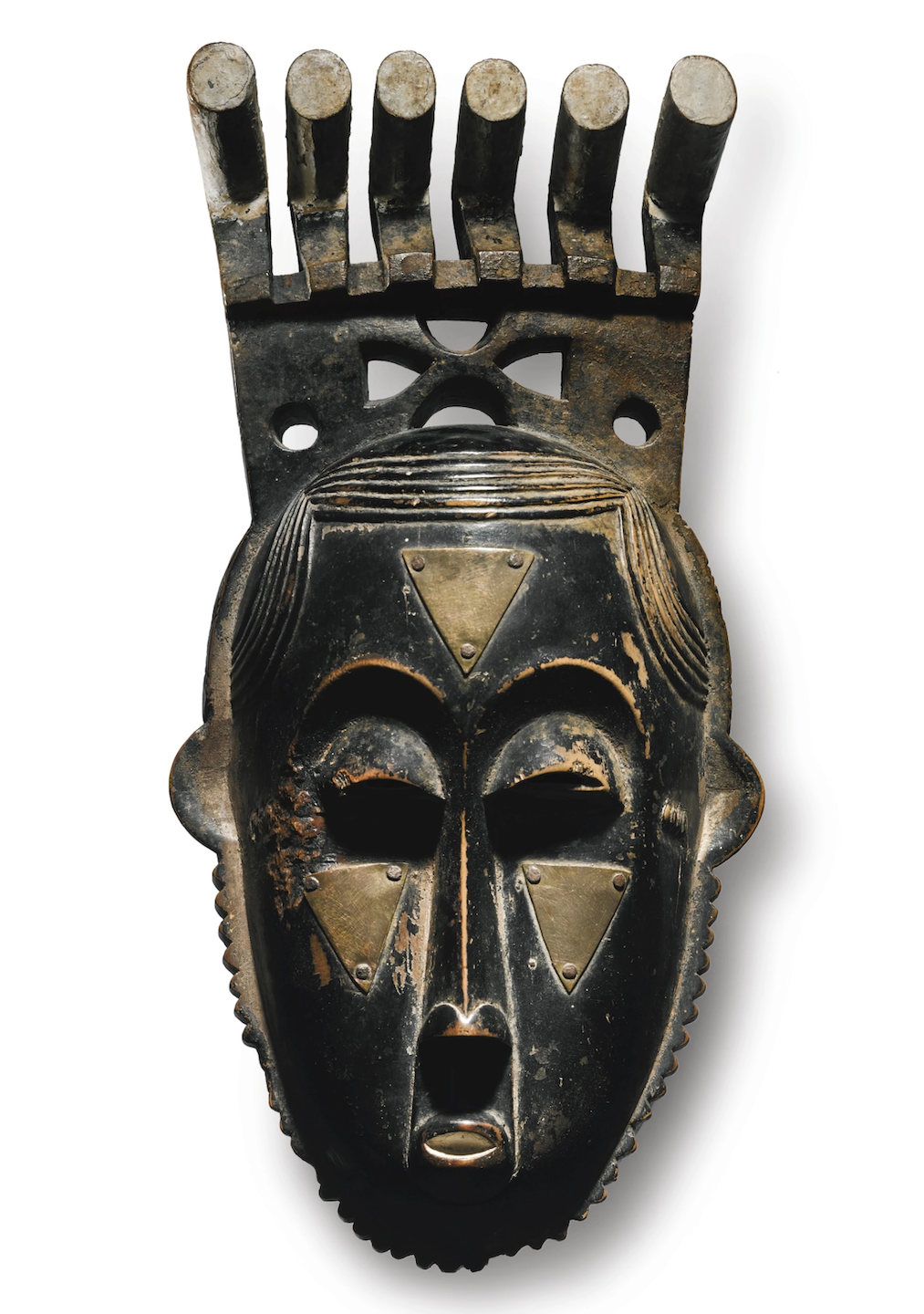
Portrait mask (Mblo) of Moya Yanso
Presented at performances in which an individual is honored with ritual dances. This one was made by the artist Owie Kimou. An idealized representation of a real person.
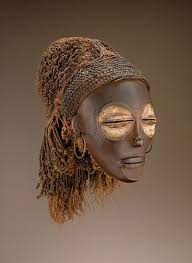
Female (Pwo) mask
Male dancers are covered with their identities masked; they are dressed as women with braided hair. During the ritual, men move like women. Marks around the eyes may suggest tears
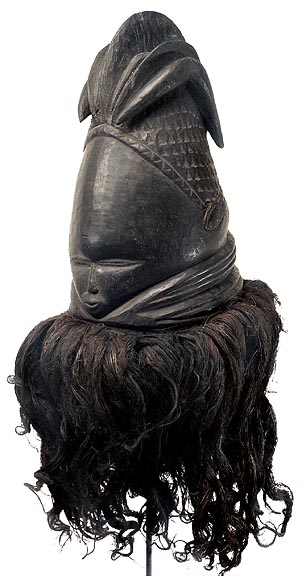
Mende Bundu mask
Idealized female beauty, both physically and morally. Small horizontal features. Used by the elder women of the Sande society; and for initiation rites

Ikenga (shrine figure)
Carved from hardwoods, considered masculine.embraces traditional masculine associations of strength and potency. It is maintained in the man’s home and is destroyed when the owner dies
Ikenga
This word means “strong right arm” and thus physical prowess.
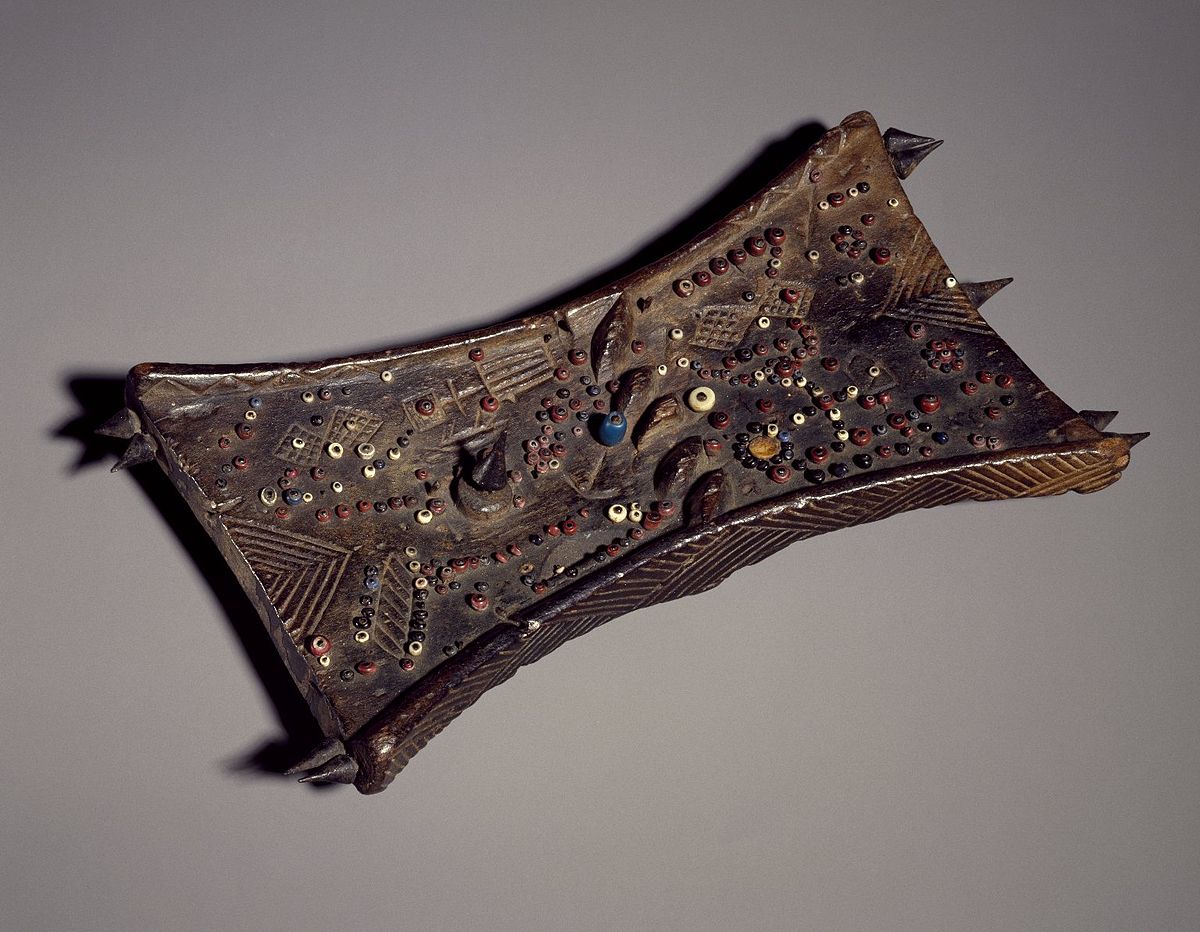
Lukasa (memory board)
Carved from wood in an hourglass shape and adorned with beads, shells, or metal. Court historian who serves as reader of the board holds the lukasa in his left hand and gently touches the beads that he will discuss with his right index finger. These are controlled by the Mbudye
Mbudye
a council of men and women who interpret the political and historical aspects of Luba society.
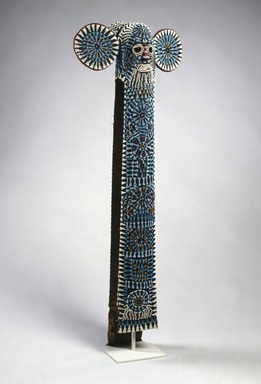
Aka elephant mask
Beadwork on a fabric backing; beadwork is a symbol of power. Has features of an elephant and human face. Performance art: maskers dance barefoot to a drum and gong; they wave spears and horsetails. Only important people in society can own and wear it.
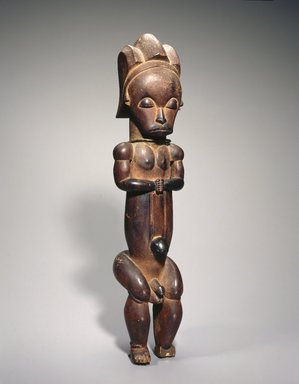
Reliquary figure (byeri)
Such figures were placed on top of cylinder-like containers made of bark that held skulls and other bones of important clan leaders. These figures were made to be portable. Emphasis on the head and the tubular nature of the body.
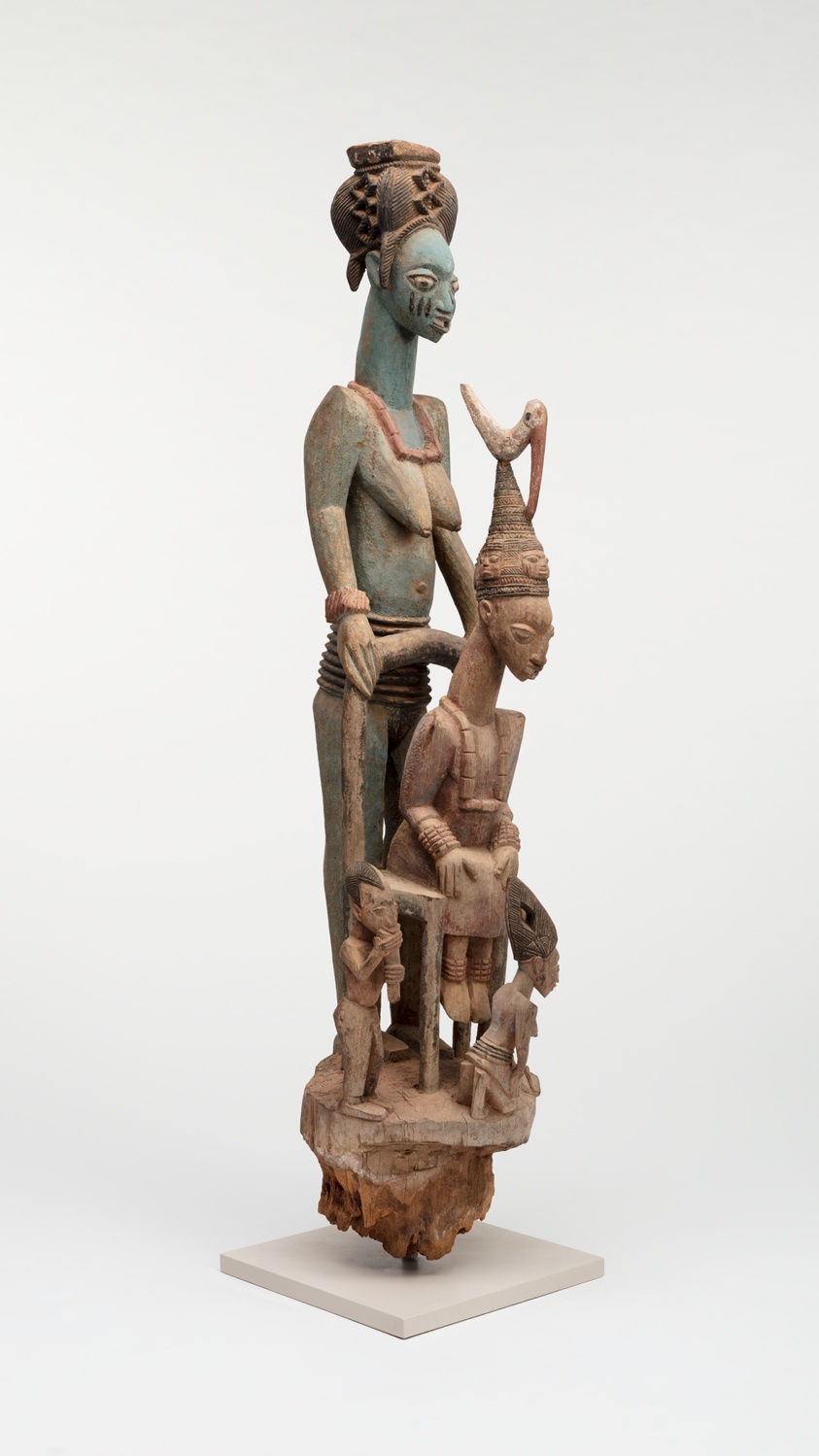
Veranda post of enthroned king and senior wife (Opo Ogoga)
Olowe of Ise carved this for the rulers of the Ekiti-Yoruba kingdom in Nigeria. One of four carved for the palace at Ikere, Nigeria. Wooden sculpture with tall vertical emphasis. Negative space creates an openness in the composition.

Chavín de Huántar
Northern highlands, Peru. Chavín. 900-200 BCE. Stone (architectural complex); granite (Lanzón and sculpture); hammered gold alloy (jewelry).
- religious capital
- 60 meters tall w/ jaguar sculpture (symbol of power)
- hidden entrance to temple led to stone corridors
- coordinated w/ adjacent river --> reference to water sources and their importance to society?

Plan and Lanzón Stone (part of Chavín de Huántar)
- inside Old Temple, maze-like system of hallways
- at center, underground, is Lanzon (Spanish for "blade") stone
- fifteen feet tall; blade shaped
- depicts powerful figure part human (body) and part animal (fangs, claws)
- head of snakes and face of jaguar
- eyebrows terminate in snakes
- flat relief; designs in curvilinear pattern
- served as cult figure
- center of pilgrimage; however, few had access to Lanzon Stone
- modern scholars hypothesize that stone acted as oracle

Relief sculpture (part of Chavín de Huántar)
- located on ruins of stairway
- shows jaguars in shallow relief

Nose ornament (Chavín de Huántar)
- worn by both sexes under the nose
- held in place by semi-circular section at top
- two snake heads on either end
- makes wearer into supernatural being during ceremonies

Yaxchilán
Chiapas, Mexico. Maya. 725 CE. Limestone (architectural complex).
- city set on high terrace; plaza surrounded by important buildings
- flourished c. 300-800 CE

Structure 40, Yaxchilán
- built by ruler Bird Jaguar IV, or his son who dedicated it to him
- overlooks main plaza
- three doors leading to central room decorated w/ stucco
- roof remains nearly intact, w/ large roof comb
- corbel arch interior

Lintel 25, Structure 23, Yaxchilán
- lintel originally set above central doorway of Structure 23
- building dedicated to Lady Xoc
- Lady Xoc (bottom right) invoking Vision Serpent to commemorate husband's rise to throne
- holds bowl w/ bloodletting ceremonial items: stinging spin and bloodstained paper
- Vision Serpent has two heads: on w/ warrior emerging from mouth, other w/ Tlaloc
- inscription written as mirror image: extremely unusual in Mayan script; uncertain meaning, maybe indicates she had vision from other side of existence, and she is acting as intercessor/shaman

Structure 33, Yaxchilán
- restored temple structure
- remains of roof comb w/ perforations
- three central doorways lead to large single room
- corbel arch interior

Mesa Verde cliff dwellings
Montezuma County, Colorado. Ancestral Puebloan (Anasazi). 450-1300 CE. Sandstone.
- pueblo built into sides of cliff, housed about 250 people
- clans moved together for mutual support and defence
- top-ledge stores all supplies, cool and dry area out of way, accessible only by ladder
- plaza in front of abode structure; kivas face plaza
- each family received one room in dwelling
- farming done on plateau above pueblo, everything had to be imported into structure, including water

Great Serpent Mound
Adams County, southern Ohio. Mississippian (Eastern Woodlands). c. 1070 CE. Earthwork/effigy mound.
- many mounds enlarged and changed over years, not built in one campaign
- effigy mounds popular in Mississippian culture
- influenced by comets? astrological phenomenon? head pointed to summer solstice sunset?
- rattlesnake as symbol in Mississippian iconography; could this play a role in interpreting this mound?
- snakes associated w/ crop fertility
- no burials/tempes associated w/ this mound
- theory: representation of Halley's Comet in 1066

Templo Mayor (Main Temple)
Tenochtitlan (modern Mexico City, Mexico). Mexica (Aztec). 1375-1520 CE. Stone (temple); volcanic stone (The Coyolxauhqui Stone); jadeite (Olmec-style mask); basalt (Calendar Stone).
- Tenochtitlan laid out on grid; city seen as center of world
- two temples atop pyramid, each w/ separate staircase
- north: dedicated to Tlaloc
- south: dedicated to Huitzilopochtli
- spring and autumn equinoxes: sun rises between the two
- large braziers put on top where sacred fires burned
- temples begun in 1375; rebuilt six times, destroyed by Spanish in 1520

Coyolxauhqui Stone (part of Templo Mayor )
- "she of the golden bells", because of the bells she wars as earrings
- Aztecs similarly dismembered enemies and threw them down stares of great pyramid to land on disk of Coyolxauhqui, like Coyolxauhqui's fate
- circular relief sculpture
- Coyolxauhqui and her many brothers plotted death of mother, Coatlicue, who became pregnant after tucking a ball of feathers down her bosom; when Coyolxauhqui chopped of Coatlicue's head, child popped out of severed head fully grown, and dismembered Coyolxauhqui, who fell dead at base of shrine
- represents dismembered moon goddess placed at base of twin pyramids of Tenochtitlan
- once brilliantly painted

Calendar Stone (part of Templo Mayor)
- circular shape reflects cyclic nature of time
- place where rituals took place on certain days
- Aztecs felt they needed to feed Sun god human hearts and blood regularly
- tongue in center coming from god's mouth and sacrificial flint knife used to slash open victims
- altar to murder victims, then threw them down steps of temple to base where Coyolxauhqui Stone rests

Olmec-style mask (part of Templo Mayor)
- found on site, actually much older work executed by Olmecs
- Olmec works have characteristics frown on face; pugnacious visage; heavy lidded eyes; headgear suggested
- shows Aztecs collected and embraced artwork from other cultures

Ruler's feather headdress (probably of Motecuhzoma II)
Mexica (Aztec). 1428-1520 CE. Feathers (quetzal and cotinga) and gold.
- 400 long green feathers are tails of sacred quetzal birds; male birds produce only two such feathers each
- 400 symbolizes eternity
- headdress probably part of collection of artifacts given by Motecuhzoma (Montezuma) to Cortez for Charles V of the Holy Roman Empire

Maize cobs
Inka. c. 1440-1533 CE. Sheet metal/repoussé, metal alloys.
- maize principal food source in Andes; celebrated by having sculptures fashioned out of sheet metal
- black maize common in Peru; oxidized silver reflects that
- may have been part of garden in which full-sized metal sculptures of maize plants, and other items, were put in place alongside plants
- may have been used to ensure successful harvest

City of Cusco, plan
Central highlands, Peru. Inka. c. 1440 CE; convent added 1550-1650 CE. Andesite.
- historic capital of Inkan empire
- in shape of puma, a royal animal
- modern plaza is in the place where puma's belly would be
- head of a fortress; heart a central square

Qorikancha: main temple, church, and convent of Santo Domingo (part of City of Cusco)
- remains of Inkan Temple of the Sun form base of Santo Domingo convent built on top
- original exterior walls of Temple decorated in gold to symbolize sunshine
- ashlar masonry
- Qorikancha: golden enclosure, once was most important temple in Inkan world
- once was observatory for priests to chart skies
- interior courtyard said to have been entirely covered in gold
- walls taper upward; examples of Inkan trapezoidal architecture

Walls at Saqsa Waman (part of City Cusco)
- complex outside of Cusco, Peru, at head of puma-shaped plan
- ashlar masonry
- ramparts contain stones weighing up to 70 tons, brought from quarry two miles away

Machu Picchu
Central highlands, Peru. Inka. c. 1450-1540 CE. Granite (architectural complex).
- originally functioned as royal retreat
- estate of 15th century Inkan rulers
- so remote; probably not used for administrative purpose in Inka word
- buildings built of stone w/ perfectly carved rock rendered in precise shapes and grooved together; thatched roofs
- 200 buildings, mostly houses, some temples, palaces, baths, even astronomical observatory; mostly using basic trapezoidal shape
- terrace farming

Observatory (part of Machu Picchu)
- used to chart sun's movements
- ashlar masonry

Intihuatana Stone (part of Machu Picchu)
- "Hitching post of the Sun", aligns w/ sun at spring and autumn equinoxes when sun stands directly over pillar, creating no shadow
- Inkan ceremonies held in concert w/ this event

All-T'oqapu tunic
Inka. 1450-1540 CE. Camelid fiber and cotton.
- rectangular shape; slit in center for head, then tunic folded in half and sides sewn for arms
- composition comprised t'oqapu; individual square may be symbolic of individuals/events/places
- contains large number of t'oqapu
- wearing such an elaborate garment would indicate status
- may have been worn by Inkan ruler
- exhibits Inkan preference for abstract designs, standardization of designs, and expression of unity and order

Bandolier bag
Lenape (Delaware tribe, Eastern Woodlands). c. 1850 CE. Beadwork on leather.
- held at hip level; strap across chest
- constructed of trade cloth: cotton, woo, velvet, or leather
- beadwork not done in Americans before European contact; beads imported from Europe
- meant to be paired with men's ceremonial outfits
- indicated prestige and status
- first used completely for decoration; later had a pouch
- inspired by Europeans' ammo bags

Transformation Mask
Kwakwaka'wakw, Northwest coast of Canada. Late 19th century CE. Wood, paint, and string.
- worn by native people of Pacific Northwest, western Canada, Alaska
- worn over head as part of complete body costume
- during ritual performance, wearer opens and closes transformation mask using strings
- bird exterior opens to reveal human face on interior (w/ birdlike features, ie sharp nose)
- at moment of transformation, performer turns back to audience to conceal action and heighten mystery

Painted Elk Hide
Attributed to Cotsiogo (Cadzi Cody), Eastern Shoshone, Wind River Reservation, Wyoming. c. 1890-1900 CE. Painted elk hide.
- worn as robes over shoulders of warrior; deeds celebrated on hide
- conveyed biographical details; personal accomplishments; heroism; battles
- men painted hides to narrate event
- eventually painted hides for European and American markets
- depicted traditional aspects of Plans people culture that were nostalgia rather than practical: bison hunt w/ bow and arrow --> nomadic hunting gone, bison nearly extinct
- bison considered to be gifts from Creator
- horses in common use around 1750, liberated Plains people
- Sun Dance conducted around bison head: outlawed by US government; viewed as threat to order
- Sun Dance: men dance; others sing, prepare feast, drum , construct lodge
- teepee
- exterior poles reach spirit world or sky
- fire represents heart
- doorway faces east to meet new day

Black-on-black ceramic vessel
Maria Martínez and Julian Martínez, Tewa, Puebloan, San Ildefonso Pueblo, New Mexico. c. mid-20th century CE. Blackware ceramic.
- highly polished surfaces
- contrasts of shiny black and matte black finishes
- comes from 1000 year old tradition of pottery making in Southwest
- at time of production, pueblos in decline; modern life replacing traditional
- work sparked revival in pueblo techniques
- Maria made pots; developed and invented more shapes than traditional pueblos used
- Julian painted pots; uses revival of ancient mythic figures and designs
- exceptional symmetry; walls of even thickness; surfaces free of imperfections
Latin America
Spanish and Portuguese explorers conquered enormous swaths of territory in what is now known as ____.
Mestizo
someone of mixed European and Native American descent
Manila Galleon
Allowed commerce vessels to complete the four-month trek without interruption.
New World
The Spanish introduced the _____ to Roman Catholicism, a faith rich in imagery. Religious benefactors funded a staggering number of high-quality religious works.
Cusco, Peru
This became the first European art center in the Americas.

Frontispiece of the Codex Mendoza
Viceroyalty of New Spain (c. 1541–1542); The main scene depicts the founding of Tenochtitlán; Named after Antonio de Mendoza, viceroy of New Spain. The book uses glyphs created by Aztec artists that were later annotated in Spanish.
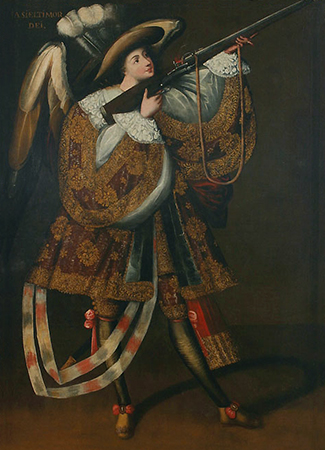
Angel with Arquebus (Asiel Timor Dei)
By Master of Calamarca (La Paz School)The angel is depicted with an arquebus (a form of rifle) instead of a traditional sword.one in a series of angel drummers, buglers, standard bearers, and holders of swords. The Master of Calamarca may have been José López de los Ríos
Screen with the Siege of Belgrade and a hunting scene
Circle of the González family (1697–1701)Only known example of an artwork that combines biombos and enconchados. Commissioned by José Sarmiento de Valladares. Displayed in Viceregal Palace in Mexico City.
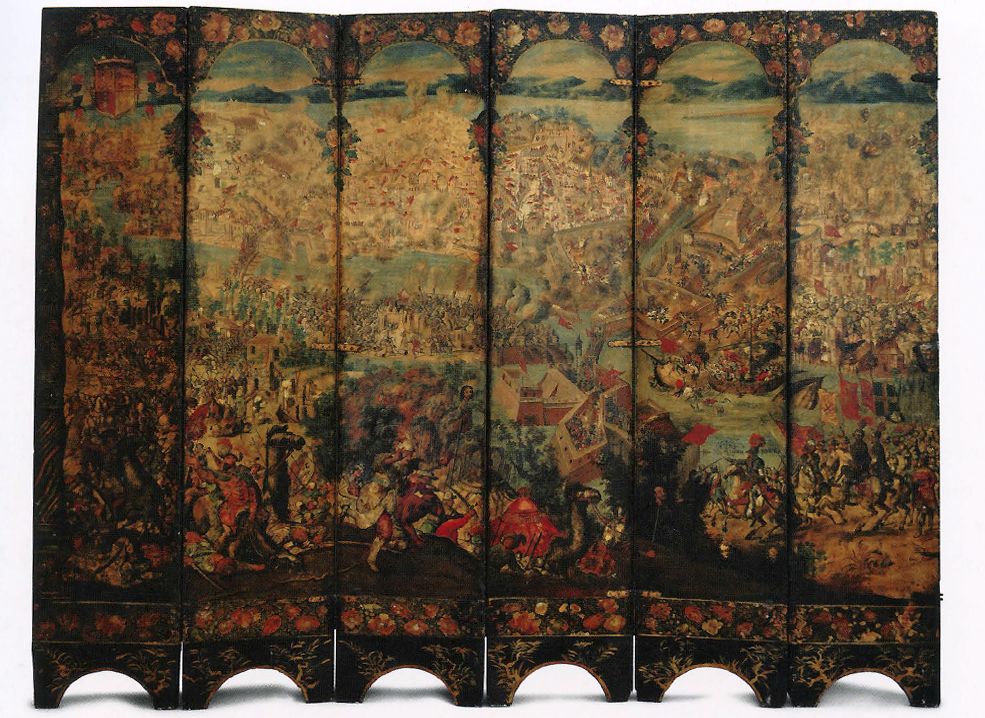
Screen with the Siege of Belgrade (Hunting Scene)
suited to an intimate space for small receptions. Dased on tapestry designs for the Medici. The design is derived from prints exported from Europe
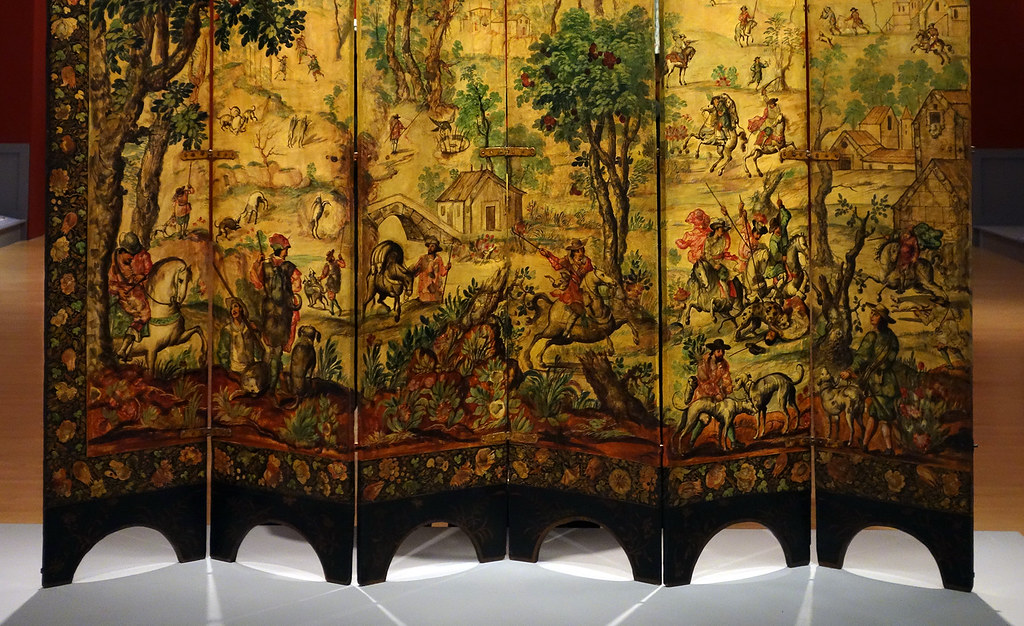
Screen with the Siege of Belgrade (War Scene)
more suited for a grander room of political importance. Depicts the contemporary event of the Great Turkish War; illustrates a scene of Hapsburg power.
Biombos
folding freestanding screens
Enconchados
shell-inlay paintings; tiny fragments of mother-of-pearl placed onto a wooden support and canvas and covered with a yellowish tint and thin glazes of paint
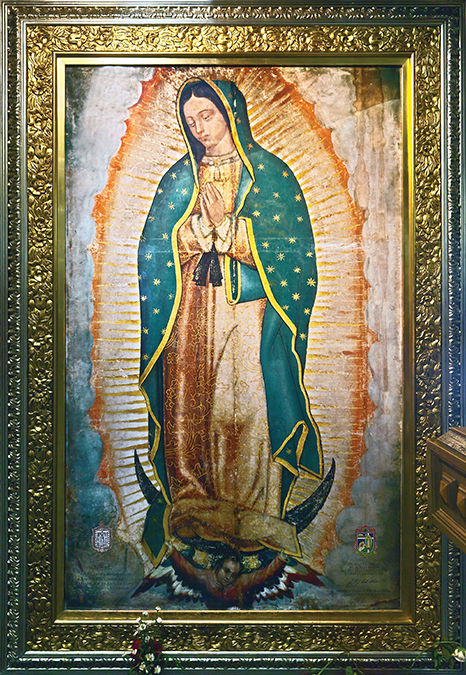
Virgin of Guadalupe
By Miguel González (1698)Based on original Virgin of Guadalupe. The painting describes an event in which Mary appeared to Native Americans on Tepeyac; Revelations 12:1
Tepeyac
a shrine sacred to a pre-Columbian goddess.
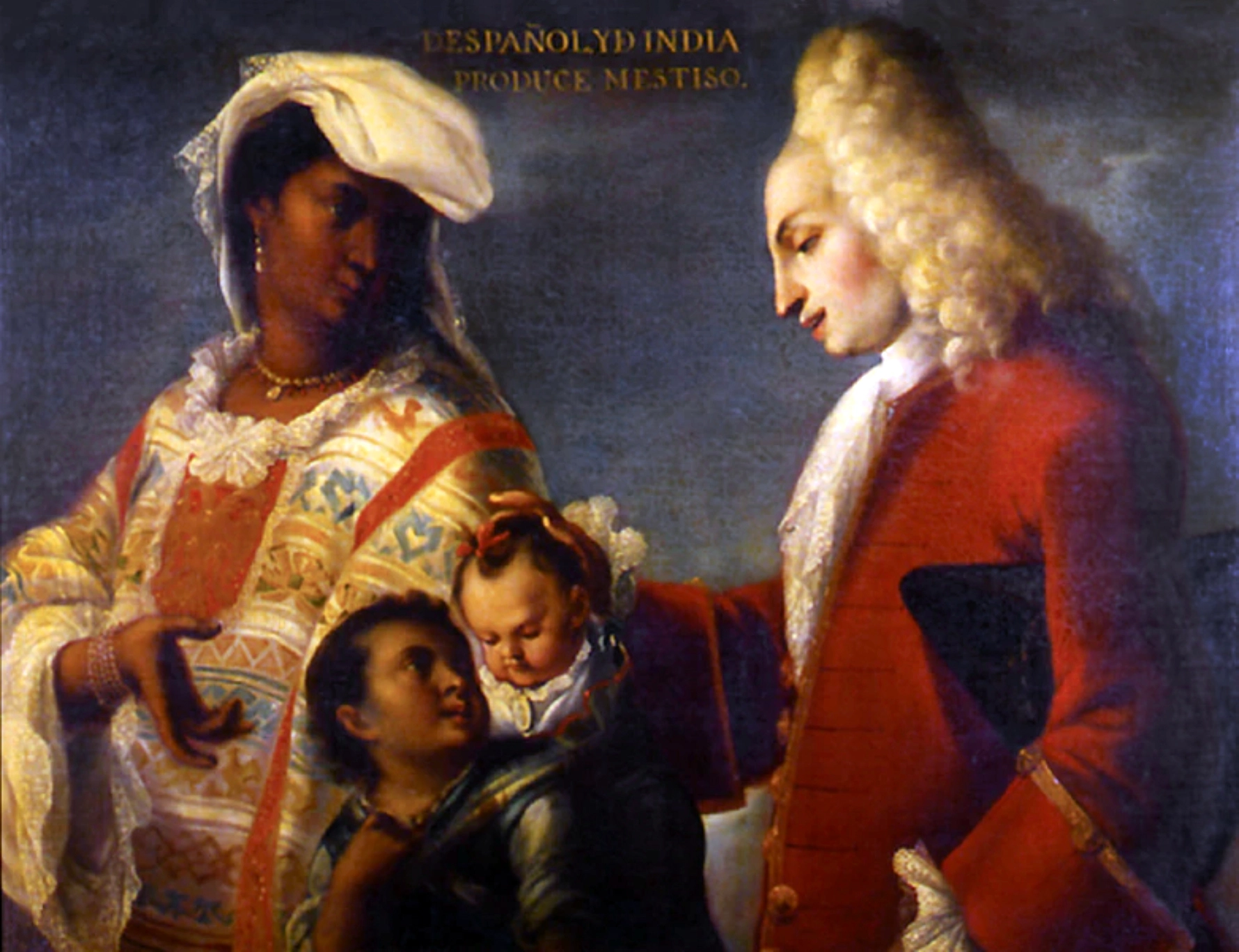
Spaniard and Indian Produce a Mestizo
Attributed to Juan Rodríguez Juárez (c. 1715)Spanish colonists commissioned these works to be sent abroad to show the caste system of the New World. Panel from the first known series of casta paintings
Casta paintings
paintings from New Spain showing people of mixed races

Portrait of Sor Juana Inés de la Cruz
By Miguel Cabrera (1750); Painting was done for her admirers 55 years after Sor Juana Inés’s death. Portrayed seated in her library surrounded by symbols of her faith and her learning.
Sor Juana Inés de la Cruz
She was a criollo woman who became a nun in 1669.a literary figure who wrote books that were widely read; she also wrote poetry and theatrical pieces, and maintained a great library.
Industrial Revolution
The __ began in the latter half of the eighteenth century, and while it brought about improvements in quality of life, it was frequently countered by a new form of slavery to mechanized labor and harsh working conditions.
Enlightenment
A period of new intellectual development during which scientists and philosophers began to base their theories on logic and observation rather than on received wisdom and tradition.
Diderot
He organized and edited a massive 52-volume French encyclopedia in 1764
Johnson
He composed the first English dictionary singlehandedly in 1755
Rousseau
He discussed how a legitimate government was an expression of the general will in his 1762 Social Contract.
Johann Winckelmann
He publish The History of Ancient Art in 1764 when he discovered Pompeii
Academy
an institution whose main objectives include training artists in an academic tradition, ennobling the profession, and holding exhibitions
French Academy
They showcased selected works by its members in an annual or biannual event called the Salon, which greatly increased an artist's prestige and the value of their paintings.
Salon
a government-sponsored exhibition of artworks held in Paris in the eighteenth and nineteenth centuries
Grand Tour
in order to complete their education young Englishmen and Americans in the eighteenth century undertook a journey to Italy to absorb ancient and Renaissance sites
Fête galante
an eighteenth-century French style of painting that depicts the aristocracy walking through a forested landscape
Rococo art
This art is sensual and erotic, with playful scenes of love and romance that tease the imagination.
Rococo paintings
These paintings features curvy, delicate frames with limbs of figures spilling over the sides, blurring the line between painting and sculpture.
Pastel
a colored chalk that when mixed with other ingredients produces a medium that has a soft and delicate hue
Satirical Paintings
Eighteenth-Century English Painting was known mostly for _____.
Neoclassical buildings
These were not simply imitations of ancient architecture but rather a smart adaptation of classical principles for modern living.
Monticello
It is a “little mountain” in Italian, sited on a hilltop in Virginia.
exemplum virtutis
Paintings like the retelling of the story of the Horatii were called ____, as they emphasized self-sacrifice for the greater good.
Bronze
It was the most expensive and highly prized sculptural medium before the Industrial Revolution.
13 colonies united in a cause
Washington leans on the Roman fasces: a group of rods bound together on the top and the bottom; the 13 rods symbolize the _.
wild frontier
Arrows between the rods likely refer to Native Americans or the idea of America as _____.
Plow
____ behind Washington symbolizes his plantation as well as the planting of a new world order.
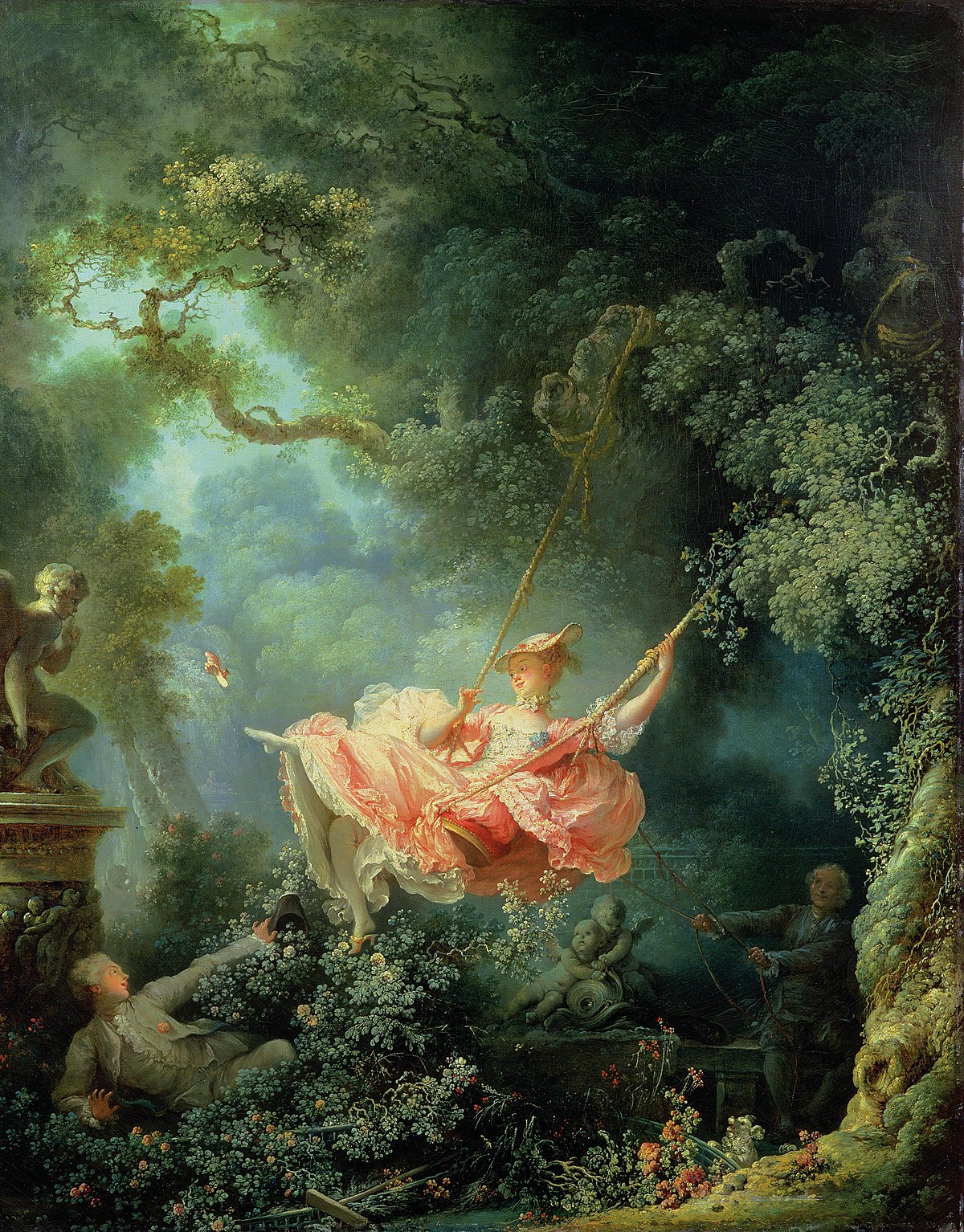
The Swing
By Jean-Honoré Fragonard (1767); Pastel palette; light brushwork; a dreamlike setting. Commissioned by an unnamed “gentleman of the Court.” Fragonard answers the libertine intentions of his patron by painting in the Rococo style.